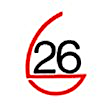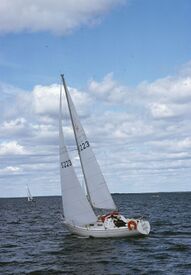Engineering:Accent 26
 | |
 | |
| Development | |
|---|---|
| Designer | Peter Norlin |
| Location | Sweden |
| Year | 1975 |
| No. built | 760 |
| Builder(s) | Albin Marine Shipman Sweden AB |
| Role | Cruiser-Racer |
| Boat | |
| Boat weight | 5,512 lb (2,500 kg) |
| Draft | 5.05 ft (1.54 m) |
| Hull | |
| Type | monohull |
| Construction | fibreglass |
| LOA | 26.41 ft (8.05 m) |
| LWL | 20.51 ft (6.25 m) |
| Beam | 9.09 ft (2.77 m) |
| Engine type | Yanmar 8 hp (6 kW) diesel engine |
| Hull appendages | |
| Keel/board type | fin keel |
| Ballast | 1,962 lb (890 kg) |
| Rudder(s) | skeg-mounted rudder |
| Rig | |
| Rig type | Bermuda rig |
| I (foretriangle height) | 32.81 ft (10.00 m) |
| J (foretriangle base) | 9.84 ft (3.00 m) |
| P (mainsail luff) | 28.87 ft (8.80 m) |
| E (mainsail foot) | 8.20 ft (2.50 m) |
| Sails | |
| Sailplan | masthead sloop |
| Mainsail area | 129 sq ft (12.0 m2) |
| Jib/genoa area | 161.43 sq ft (14.997 m2) |
| Gennaker area | 179 sq ft (16.6 m2) |
The Accent 26, also called the Albin Accent and the Shipman Accent, is a Swedish sailboat that was designed by Peter Norlin as an International Offshore Rule Quarter Ton class cruiser-racer and first built in 1975.[1][2][3][4]
Production
The design was built by both Albin Marine and Shipman Sweden AB in Sweden, from 1975 to 1980, with a total of 760 boats completed, but it is now out of production.[1][2][5][6][7][8]
Design
The Accent 26 is a recreational keelboat, built predominantly of fibreglass, with wood trim. It has a masthead sloop rig with aluminum spars, a deck-stepped mast, wire standing rigging and a single set of unswept spreaders. The hull has a raked stem; a raised counter, reverse transom; a skeg-mounted rudder controlled by a tiller and a fixed fin keel. It displaces 5,512 lb (2,500 kg) and carries 1,962 lb (890 kg) of iron ballast.[1][2]
The boat has a draft of 5.05 ft (1.54 m) with the standard keel. It is fitted with a Japanese Yanmar diesel engine of 8 hp (6 kW) for docking and manoeuvring.[1][2]
The design has sleeping accommodation for six people, with a double "V"-berth in the bow cabin, an L-shaped settee and a straight settee in the main cabin and two aft quarter berths. There is a drop-leaf table in the main cabin. The galley is located on the starboard side just forward of the companionway ladder. The galley is equipped with a two-burner stove and a double sink. The enclosed head is located just aft of the bow cabin on the starboard side.[1][2]
The design has a hull speed of 6.07 kn (11.24 km/h).[2]
Operational history
The prototype won the 1974 World Quarter Ton class Championships.[1]
See also
References
- ↑ 1.0 1.1 1.2 1.3 1.4 1.5 McArthur, Bruce (2020). "Accent 26 sailboat". sailboatdata.com. https://sailboatdata.com/sailboat/accent-26-albin.
- ↑ 2.0 2.1 2.2 2.3 2.4 2.5 "Accent 26". Boat-Specs.com. 2020. https://www.boat-specs.com/sailing/sailboats/albin-marine/albin-accent#nopics.
- ↑ McArthur, Bruce (2020). "Peter Norlin". sailboatdata.com. https://sailboatdata.com/designer/norlin-peter.
- ↑ "Peter Norlin". Boat-Specs.com. 2020. https://www.boat-specs.com/sailing/designers/norlin-peter.
- ↑ McArthur, Bruce (2020). "Albin Marine 1899 -". sailboatdata.com. https://sailboatdata.com/builder/albin-marine.
- ↑ "Albin Marine". Boat-Specs.com. 2020. https://www.boat-specs.com/sailing/builders/albin-marine.
- ↑ McArthur, Bruce (2020). "Shipman". sailboatdata.com. https://sailboatdata.com/builder/shipman.
- ↑ "Shipman Sweden AB". Boat-Specs.com. 2020. https://www.boat-specs.com/sailing/builders/shipman-sweden-ab.
External links
 |

